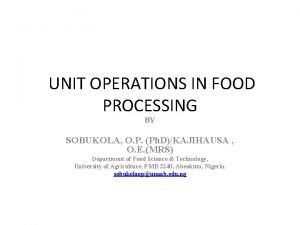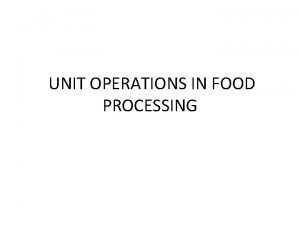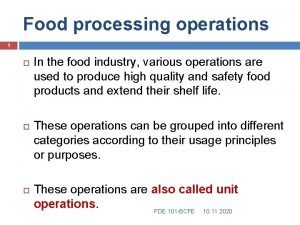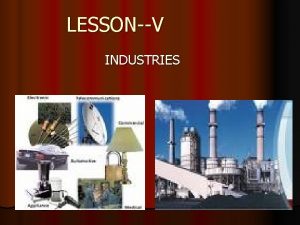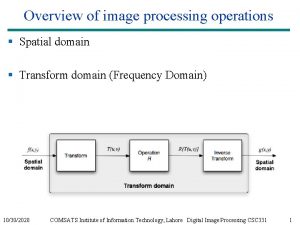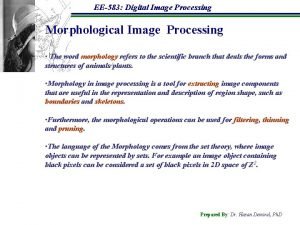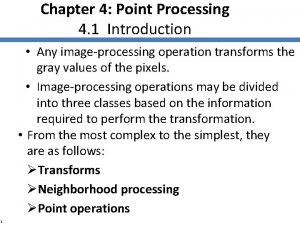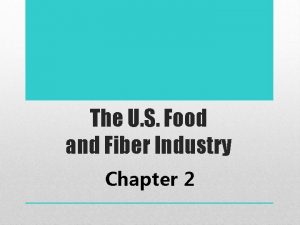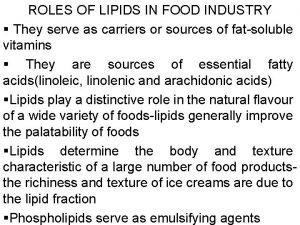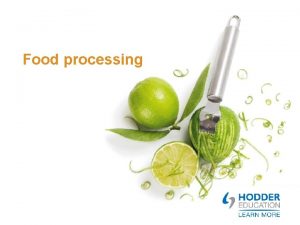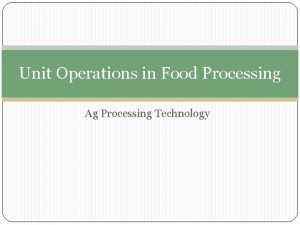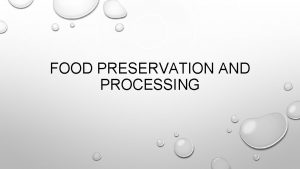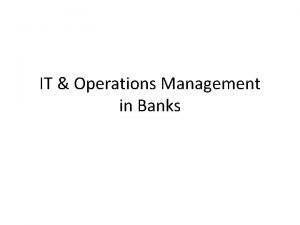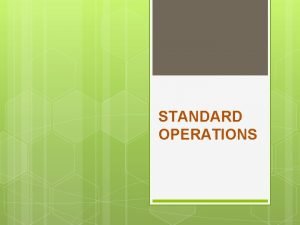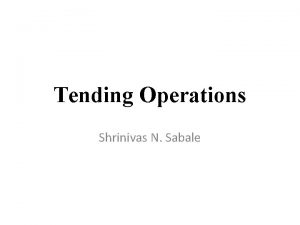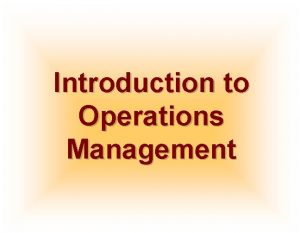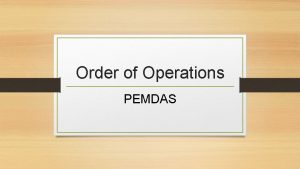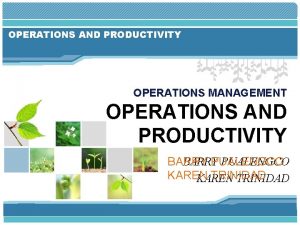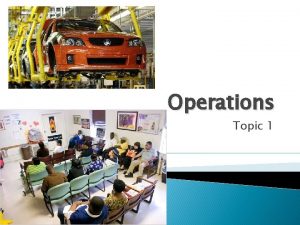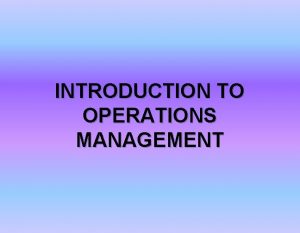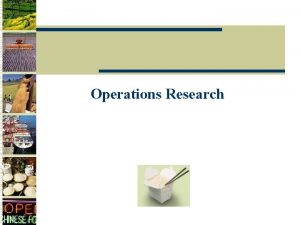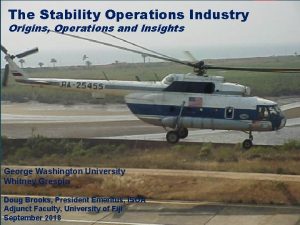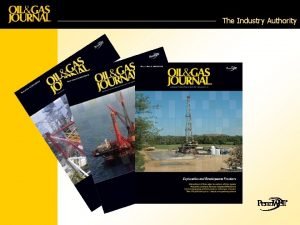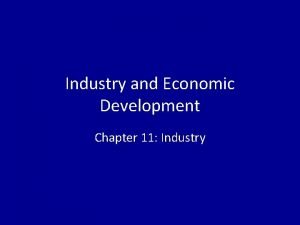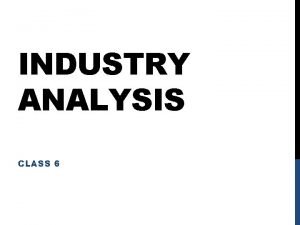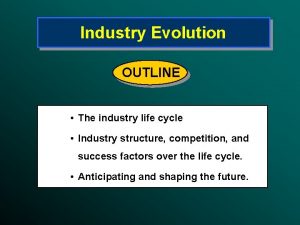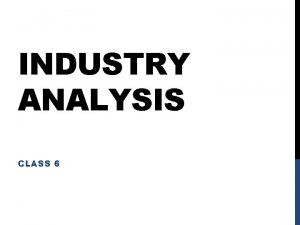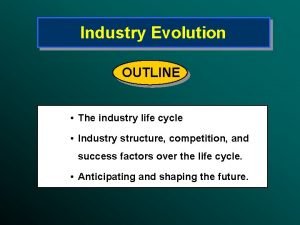Food processing operations 1 In the food industry


































































- Slides: 66

Food processing operations 1 In the food industry, various operations are used to produce high quality and safety food products and extend their shelf life. These operations can be grouped into different categories according to their usage principles or purposes. These operations are also called unit operations. FDE 101 -BCFE 10. 11. 2020

2 Classification of unit operations Unit operations, which are commonly used in the food industry from farm to fork, are classified into one of six groups as follow: Ambient temperature processing Heat processing using steam, hot water or oil Processing using hot air or heated surfaces Processing by direct and radiated energy Processing by removal of heat Post processing operations FDE 101 -BCFE 10. 11. 2020

3 Unit operations in food industry Ambient temperature processing Raw material preparation Size reduction Mixing, forming, and coating Separation process Heat process using steam, hot water or oil Processing using hot air or heated surfaces Blanching Dehydration Industrial cooking Smoking Pasteurization Baking and roasting Heat Sterilization Extrusion cooking Evaporation and distillation Frying 10. 11. 2020 FDE 101 -BCFE

4 Unit operations in food industry Processing by direct and radiated energy Processing by removal of heat Post processing operations Dielectric heating Refrigeration Packaging Ohmic heating Chilling Infrared heating Freezing Filling and sealing of containers Freeze drying and freeze concentration Materials handling, storage and distribution 10. 11. 2020 FDE 101 -BCFE

AMBIENT TEMPERATURE PROCESSING

6 Ambient temperature processing Processing, which are performed at ambient temperatures, are explained under four main titles. Raw material preparation Size reduction Mixing, forming, and coating Separation process FDE 101 -BCFE 10. 11. 2020

7 RAW MATERIAL PREPARATION FDE 101 -BCFE 10. 11. 2020

Raw material preparation 8 Preparation of raw materials is one of the important steps for food production to produce high quality products or to offer for sale in the fresh market sector In order to achieve this goal, application of one or more of unit operations, which are cooling, cleaning, sorting, grading or peeling, is neccessary FDE 101 -BCFE 10. 11. 2020

Cleaning of foods 9 Cleaning removes contaminating materials such as soil, stones, bone, metal fragments, microorganisms, fertilizers, pesticide etc… Cleaning is one of the significant steps of food processing since it prevents spread of these contaminants to uncontaminated pieces and reduces the risk of spoilage and loss of food. Cleaning is applied in two different ways: � Wet cleaning � Dry cleaning FDE 101 -BCFE 10. 11. 2020

Sorting and grading of foods 10 SORTING GRADING Sorting means the separation of foods according to their measurable physical properties such as size, shape, weight, color Grading is the assessment of overall food quality using a number of attributes such as fat distribution for beef, roasting degree for coffee, aroma and flavor intensity for cheese FDE 101 -BCFE 10. 11. 2020

11 SIZE REDUCTION FDE 101 -BCFE 10. 11. 2020

Size reduction 12 Size reduction is applied to all food process in which the food is needed to cut or broken down into smaller pieces The main benefits of size reduction are an increased surface area which enhance the rate of heat or mass transfer reduced particle size facilitate the mixing of ingredients FDE 101 -BCFE 10. 11. 2020

13 MIXING, FORMING AND COATING FDE 101 -BCFE 10. 11. 2020

Mixing, forming and coating 14 Mixing operation is required whenever an ingredient is added to a food The main purpose of the mixing is obtain a homogenous final mixture by using two or more solid, liquid or gas components Addition of water into corn syrup (liquid to liquid) Addition of sugar into flour (solid to solid) Addition of sugar into fruit juice (solid to liquid) Diffusion of air into ice cream dough during ice 10. 11. 2020 cream making (gas to liquid) FDE 101 -BCFE

Calculation of uniformity of mixing and required mixing time 15 : standard deviation n : number of samples c : concentration of the component in each sample : the mean concentration of samples : Standard deviation of a perfectly mixed sample : Standard deviation of a sample at the start of mixing : Standard deviation of a sample taken during mixing 10. 11. 2020 FDE 101 -BCFE

Problem 16 FDE 101 -BCFE 10. 11. 2020

Agitation of liquid materials 17 Agitation is used for liquid foods. For example blend one liquid into another miscible liquid � to disperse gas in a liquid � to disperse one liquid into another immiscible liquid Access link https: //www. youtube. com/watch? v= 23 X 1 e. B 5 Kry. Q � to Liquid agitator FDE 101 -BCFE 10. 11. 2020

Froude number 18 Froude number is a dimensionless number, which is ratio of the inertial force to gravitational force � If the vessel has blades, the role of the Froude number is negligible � If the vessel has no blade, we have to take into consider the role of the Froude number N: Rotational speed (revolution/s) Di: Diameter of the impeller (m) μ: Viscosity of the liquid (kg/ms) : Accelaration due to gravity (m/s 2) FDE 101 -BCFE 10. 11. 2020

The curve drawn to find Np 19 FDE 101 -BCFE 10. 11. 2020

Problem 20 A concentrated fruit juice with a viscosity of 0. 03 kg/ms and a density of 1100 kg/m 3 is being agitated in an agitation system containing a turbine impeller. The impeller has a disk with six blades. The tank diameter is 1. 8 m. The height of the liquid in the tank is the same as the tank diameter. The impeller diameter is 0. 5 m. The width of the blade is 0. 1 m. The tank is equipped with four baffles, each with a width of 0. 15 m. If the turbine is operated at 100 rpm, determine the required power. FDE 101 -BCFE 10. 11. 2020

21 SEPARATION PROCESSES FDE 101 -BCFE 10. 11. 2020

Separation process 22 This operation is designed for the separation or physical removal of food components Centrifugation Main separation processes Filtration Extraction using solvents Expression (pressing) Membrane separation 10. 11. 2020 FDE 101 -BCFE

23 CENTRIFUGATION FDE 101 -BCFE 10. 11. 2020

Centrifugation 24 Two main applications of centrifugation used in the food industry are separation of immiscible liquids and separation of solids from liquids The separation factor is centrifugal force, which is generated when materials are rotated. The size of the force depends on the radius, speed of rotation and the density of the centrifuged materials. FDE 101 -BCFE 10. 11. 2020

Working principles of centrifugation Medium phase Acceleratio n force acts towards the centre of the cycle 25 Light phase Centrifugal force acts outwards from the centre Heavy phase When a material (milk) is exposed to centrifugation, the heavier phase (water in milk) moves to the wall of the centrifuge and the lighter phase (fat in milk) is displaced to an inner annulus of the centrifuge as a result of the

Animation for centrifugation 26 Access link : https: //www. youtube. com/watch? v=s. Dhue. H 3 q 6 Y 4 FDE 101 -BCFE 10. 11. 2020

Basic equations related with centrifugation 27 The centrifugal force is calculated by using this formula Fc: centrifugal force m: mass of the particle (kg) r: radial distance to the centre of rotation (radius) (m) ω: angular velocity of the particle (rad/s ) 2 ) : acceleration due FDE to gravity (9. 81 m/s 101 -BCFE 10. 11. 2020

28 Calculation for centrifugal force Centrifuge speeds are normally expressed as in revolution per minute (rpm) N: revolution per minute FDE 101 -BCFE 10. 11. 2020

29 Calculation for the rate of seperation The rate of separation as expressed by velocity is calculated by formula given below This formula is used to calculate the separation rate between two phases (solid in liquid) with different densities FDE 101 -BCFE 10. 11. 2020

30 Calculation for the rate of seperation Velocity for separation (m/s) D: Particle diameter (m) N: Rotation speed (rpm) r: Radius (m) ρp: Density of the continous phase (kg/m 3) ρs : Density of the dispersed phase (kg/m 3) μ: Viscosity of the continous phase (kg/ms) FDE 101 -BCFE 10. 11. 2020

What is density and viscosity 31 Viscosity is defined as resistance to flow of a liquid Water vs. honey Density is the amount of material mass in a given volume FDE 101 -BCFE 10. 11. 2020

Problems 32 Beef is clarified from the unwanted compounds by using centrifugate operation at 2600 rpm, with a radius of 15 cm. Calculate the centrifugal force for this operation. FDE 101 -BCFE 10. 11. 2020

Problems 33 The solid particles in a liquid-solid suspension are to be separated by centrifugal force. The particles are 100 microns in diameter with a density of 800 kg/m 3. The liquid is water with a density of 993 kg/m 3, and the effective radius separation is 7. 5 cm. If the required velocity for separation is 0. 03 m/s, determine the rotation speed for the centrifuge. FDE 101 -BCFE 10. 11. 2020

Liquid-liquid separation r. A: radius for the heavy phase outlet r. B: radius for the light phase outlet rn: radius for inlet (feeding) 34 FDE 101 -BCFE 10. 11. 2020

Calculation of inlet radius 35 The formula given below is used to determine the position/radius of feed and discharge pipes and to design of the separation cylinder for liquid-liquid systems ρA: Density of the heavier phasee ρB : Density of the lighter phase r. A/r 1: radius for the heavy phase outlet rb/r 1: radius for the light phase outlet rn: radius for the inlet FDE 101 -BCFE 10. 11. 2020

Problems 36 Cream is separated from the whole milk by using centrifugation. The density for the skim milk is 1025 kg/m 3 and it has a 5 cm outlet radius. Radius of cream outlet is 2. 5 cm and the density for cream is 865 kg/m 3. Design the separation cylinder and suggest a required radius for the feeding (inlet). FDE 101 -BCFE 10. 11. 2020

37 FILTRATION FDE 101 -BCFE 10. 11. 2020

Filtration 38 Filtration is the removal of insoluble solids from a liquids by passing it through a porous material Filtration is used to clarify wine, beer, juices, oils and syrups in the food Filter medium FDE 101 -BCFE 10. 11. 2020

Formation of filter cake 39 The solids removed from the liquid accumulate in the filter medium, which is called filter cake. The formation of filter cake and its thickness affect the filtration rate as shown in the figure A significant decrease in the rate of filtration process 10. 11. 2020 FDE 101 -BCFE

40 Factors that affect the filtration rate The factors, which affect the filtration rate, are listed below � The presence and thickness of filter cake (the resistance of the filter cake) � The pressure drop across the filter medium � The area of the filtering surface � The viscosity of the filtrate � The resistance of the filter medium FDE 101 -BCFE 10. 11. 2020

Calculation of filtration rate 41 The rate of filtration can be described as the ratio of driving force (the pressure required to move the fluid through the filter medium) to resistance The mathematical equation to calculate rate of filtration is given below Volumetric flow rate FDE 101 -BCFE 10. 11. 2020 (m 3/s)

Filtration process 42 The filtration process may occur in two phases Constant-rate filtration, which is normally occur during the early stages of the process Constant-pressure filtration, which is occur during the final stages of the process FDE 101 -BCFE 10. 11. 2020

Constant-rate filtration 43 Constant-rate filtration is shown by the formula given below, which is used to determine the required pressure drop as a function of the filtration rate Reorganize the formula If the thickness of the filter medium (L) is negligible, the equation is corrected FDE 101 -BCFE 10. 11. 2020

Constant-rate filtration 44 The equation given below is used to predict pressure drop requirements for a filter during the early stages of the process ∆P: Pressure drop requirements (Pa) µ: Viscosity of the fluid (kg/ms) r’: The spesific resistance of the filter cake S: Solid content of the fluid A: Cross-sectional area of the filter (m 2) V: Volume (m 3) t: The filtration time (s) FDE 101 -BCFE 10. 11. 2020

Problem 45 An air filter is used to remove small particles from an air supply to a quality control laboratory. The air (0°C) is supplied at a rate of 0. 5 m 3/s through an air filter with a 0. 5 m 2 cross-sectional area. If the pressure drop across the filter is 0. 25 cm water after one hour of use, determine the life of the filter if a filter change is required when the pressure drop is 2. 5 cm of water. Assumption: Due to the nature of air filtration, constantrate filtration can be assumed and the filter medium thickness is negligible. Use the table (A. 4. 4) given at next slide to find the viscosity of the air. FDE 101 -BCFE 10. 11. 2020

46 FDE 101 -BCFE 10. 11. 2020

Constant-pressure filtration 47 The equation used to define the constant-pressure filtration is given below If the medium thickness (L) is negligible, the equation is corrected ∆P: Pressure drop requirements (Pa) µ: Viscosity of the fluid (kg/ms) r’: The spesific resistance of the filter cake S: Solid content of the fluid A: Cross-sectional area of the filter (m 2) V: Volume (m 3) t: The filtration time (s) FDE 101 -BCFE 10. 11. 2020

Problem 48 The liquid is filtered at a pressure of 200 k. Pa through a 0. 2 m 2 filter. Initial results indicate that 5 min is required to filter 0. 3 m 3 of liquid. Determine the time that will elapse until the rate of filtration drops to 5 x 10 -5 m 3/s. Assumption: Due to information given in the question, filtration is assumed to be constantpressure condition and the filter medium thickness (L) is negligible. FDE 101 -BCFE 10. 11. 2020

Main factors affecting the filtration process 49 The rate of filtration is directly dependent on two main factors: filter medium and fluid being filtered Filter medium is described in terms of filtration area and the spesific resistance of filter medium. • When the area increases, the filtration rate increases. • When the resistance against to filtration increases as a result of filter cake formation, the filtration rate decreases. Formula for the calculation of filtration rate FDE 101 -BCFE Fluid being filtered as described by the viscosity of the fluid. The filtration rate and the fluid viscosity are inversely related. • As the viscosity of the fluid increases, the filtration rate decreases. 10. 11. 2020

Design of a filtration system 50 The usage of equations given for constant-rate and constant-pressure filtration systems requires knowlegde of several parameters. However, in most cases, viscosity and spesific resistance values may not be known. Additionally, filter medium thickness (L) is not assumed to be negligible. A small or pilot-scale operation in the food industry results in determination of filtration rate after given periods of time at a constant-pressure on the small scale filter. FDE 101 -BCFE 10. 11. 2020

Design of a filtration system 51 We can use the formula given below to design the filtration system, which is also used to define the constant-pressure filtration systems. FDE 101 -BCFE 10. 11. 2020

Design of a filtration system (an approach) 52 If we resemble this equation to another basic equation b, which is called intercept, is equal to y = ax + b x is equal to a, which is called slope, is equal to FDE 101 -BCFE 10. 11. 2020

Design of a filtration system (an approach) 53 If we draw a filtration graph by using the information given in the slide, which is the previous one, Y AXIS y = ax + b X AXIS FDE 101 -BCFE 10. 11. 2020

Problem 54 FDE 101 -BCFE 10. 11. 2020

Problem (cont. ) 55 Desired conditions � Volume (V): 4 m 3 � Time (t): 2 hour � Pressure (∆P): 400 k. Pa Designed conditions � Area (A): 0. 1 m 2 � Pressure (∆P): 140 k. Pa FDE 101 -BCFE 10. 11. 2020

Problem (cont. ) 56 slope FDE 101 -BCFE 10. 11. 2020 intercep t

Problem (cont. ) 57 Desired conditions � Volume (V): 4 m 3 � Time (t): 2 hour � Pressure (∆P): 400 k. Pa Designed conditions � Area (A): 0. 1 m 2 � Pressure (∆P): 140 k. Pa Slope 0. 6249 � Ouestion: Filter area ? ? ? Intercept 29. 827 FDE 101 -BCFE 10. 11. 2020

58 EXTRACTION USING SOLVENTS (Solid-liquid extraction) FDE 101 -BCFE 10. 11. 2020

Extraction using solvents 59 Solid-liquid extraction is defined as removal of a desired compound, which is called solute, from a food by using a liquid, which is called solvent Extraction process has many application areas in the food industry such as Extraction of oil from oilseeds and nuts Extraction of essential oil and flavor compounds from herbs, spices, fruits and vegetables Coffee, tea, and decaffeinated coffee and tea FDE 101 -BCFE 10. 11. 2020

Some examples for the solid-liquid extraction process 60 Oil extraction from nuts Oil extraction from herbs Extraction of flavor and color compounds from 10. 11. 2020 tea by using hot water FDE 101 -BCFE

61 Theory of the solid-liquid extraction The solid-liquid extraction involves mixing the food and solvent together, holding for a time and then separating the solvent During the holding period of time, the mass transfer of solid compounds occur in three stages: The solvent enters into the food and dissolve the targeted solute The solute trapped in the solvent moves through the surface of the food The solute becomes dispersed in the bulk of the solvent FDE 101 -BCFE 10. 11. 2020

Extraction using solvents Access link: https: //www. youtube. com/watch? v=c. F 4_RRNIGAc 62 FDE 101 -BCFE 10. 11. 2020

Factors affecting the extraction process 63 1. The solubility properties of a solid compound in the solvent 2. The temperature of the extraction: Higher temperatures cause extraction of undesirable compounds and heat damage; although, it increases the rate of extraction 3. The surface area of the solid: Large surface increases the extraction rate 4. Viscosity of the solvent: As the viscosity decreases, the rate of extraction increases due to easily penetration ability of less viscosious solvents 5. Flowrate of solvent: As the flowrate increases, the rate of 10. 11. 2020 FDE 101 -BCFE extraction increases

Extraction using solvents 64 Common types of solvents used for extraction process are water, organic solvents, and supercritical fluids Water is the most convenient, cost-effective, and environmentally friendly solvent. It is widely used for the production of sugar, coffee, and tea Oils and fats are needed organic solvents (such as acetone, butane, ethanol, hexane, methanol etc. ) for extraction since they are water-insoluble Among supercritical fluids, supercritical CO 2 is generally used for the extraction process FDE 101 -BCFE 10. 11. 2020

Supercritical CO 2 65 These fluids has different physical properties from liquids and gases Supercritical CO 2 acts is a liquid but it difuses like a gas It has low viscosity It needs low temperature for extraction It is effectively used in the extraction process due to the advantages of these 31. 06°C FDE 101 -BCFE 10. 11. 2020

References 66 Singh, R. P. and Heldman D. R. (2009) Introduction to food engineering. Chapter 13: Supplemental processes. Pages 689 -720. (4 th ed. ) Academic Press, California, USA (In the library of our department) Fellows, P. J. (2017). Food processing technology principles and practice. Part II Ambient Temperature Processing. Pages 201 -386. (4 th ed. ) Woodhead Publishing, Duxford, United Kingdom Campbell-Platt, G. (2009). Food Science and Technology. Chapter 9: Food processing, Unit operations. Pages 219234. Blackwell Publishing (In the library of our department) FDE 101 -BCFE 10. 11. 2020
 Fractal
Fractal Unit operations in food processing
Unit operations in food processing Sorting and grading in food processing
Sorting and grading in food processing Food processing operations
Food processing operations Processing industry definition
Processing industry definition Spatial operations in image processing
Spatial operations in image processing Image processing
Image processing Point processing operations
Point processing operations Neighborhood processing in image processing
Neighborhood processing in image processing Bottom up processing
Bottom up processing Gloria suarez
Gloria suarez Bottom up processing
Bottom up processing What is primary and secondary processing
What is primary and secondary processing Histogram processing in digital image processing
Histogram processing in digital image processing Parallel processing vs concurrent processing
Parallel processing vs concurrent processing Nonlinear image processing
Nonlinear image processing Image processing
Image processing Morphological dilation
Morphological dilation Top-down processing example
Top-down processing example Interactive processing
Interactive processing Hình ảnh bộ gõ cơ thể búng tay
Hình ảnh bộ gõ cơ thể búng tay Slidetodoc
Slidetodoc Bổ thể
Bổ thể Tỉ lệ cơ thể trẻ em
Tỉ lệ cơ thể trẻ em Voi kéo gỗ như thế nào
Voi kéo gỗ như thế nào Tư thế worm breton là gì
Tư thế worm breton là gì Chúa yêu trần thế alleluia
Chúa yêu trần thế alleluia Các môn thể thao bắt đầu bằng tiếng chạy
Các môn thể thao bắt đầu bằng tiếng chạy Thế nào là hệ số cao nhất
Thế nào là hệ số cao nhất Các châu lục và đại dương trên thế giới
Các châu lục và đại dương trên thế giới Công thức tính độ biến thiên đông lượng
Công thức tính độ biến thiên đông lượng Trời xanh đây là của chúng ta thể thơ
Trời xanh đây là của chúng ta thể thơ Mật thư tọa độ 5x5
Mật thư tọa độ 5x5 Phép trừ bù
Phép trừ bù độ dài liên kết
độ dài liên kết Các châu lục và đại dương trên thế giới
Các châu lục và đại dương trên thế giới Thể thơ truyền thống
Thể thơ truyền thống Quá trình desamine hóa có thể tạo ra
Quá trình desamine hóa có thể tạo ra Một số thể thơ truyền thống
Một số thể thơ truyền thống Cái miệng nó xinh thế chỉ nói điều hay thôi
Cái miệng nó xinh thế chỉ nói điều hay thôi Vẽ hình chiếu vuông góc của vật thể sau
Vẽ hình chiếu vuông góc của vật thể sau Nguyên nhân của sự mỏi cơ sinh 8
Nguyên nhân của sự mỏi cơ sinh 8 đặc điểm cơ thể của người tối cổ
đặc điểm cơ thể của người tối cổ Thứ tự các dấu thăng giáng ở hóa biểu
Thứ tự các dấu thăng giáng ở hóa biểu Vẽ hình chiếu đứng bằng cạnh của vật thể
Vẽ hình chiếu đứng bằng cạnh của vật thể Phối cảnh
Phối cảnh Thẻ vin
Thẻ vin đại từ thay thế
đại từ thay thế điện thế nghỉ
điện thế nghỉ Tư thế ngồi viết
Tư thế ngồi viết Diễn thế sinh thái là
Diễn thế sinh thái là Các loại đột biến cấu trúc nhiễm sắc thể
Các loại đột biến cấu trúc nhiễm sắc thể Thế nào là số nguyên tố
Thế nào là số nguyên tố Tư thế ngồi viết
Tư thế ngồi viết Lời thề hippocrates
Lời thề hippocrates Thiếu nhi thế giới liên hoan
Thiếu nhi thế giới liên hoan ưu thế lai là gì
ưu thế lai là gì Hổ đẻ mỗi lứa mấy con
Hổ đẻ mỗi lứa mấy con Khi nào hổ con có thể sống độc lập
Khi nào hổ con có thể sống độc lập Hệ hô hấp
Hệ hô hấp Từ ngữ thể hiện lòng nhân hậu
Từ ngữ thể hiện lòng nhân hậu Thế nào là mạng điện lắp đặt kiểu nổi
Thế nào là mạng điện lắp đặt kiểu nổi Unit 2 food food food
Unit 2 food food food Eltonian pyramid
Eltonian pyramid Food and fiber industry
Food and fiber industry Food and beverage industry in sri lanka
Food and beverage industry in sri lanka Uses of lipids in food industry
Uses of lipids in food industry

